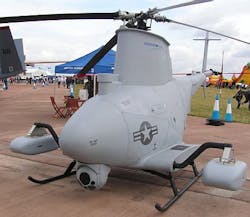Navy chooses multi-sensor electro-optical targeting pods from FLIR for copters and UAVs
CRANE, Ind., 29 Aug. 2013. U.S. Navy avionics experts needed multi-sensor electro-optical targeting systems for the UH-1 manned helicopter, the MQ-8 Fire Scout unmanned helicopter, and other unmanned vertical takeoff unmanned aerial vehicles (UAVs). They found their solution from FLIR Systems Inc. in Wilsonville, Ore.
Officials of the Naval Surface Warfare Center in Crane, Ind., awarded a $136.6 million contract to FLIR this week for BRITE Star Block II multi-sensor targeting imager for the manned and unmanned helicopters. The contract includes BRITE Star I upgrades, cables, and maintenance.
The electro-optical sensor systems are for the Naval Air Systems Command’s UH-1 program and the Vertical Takeoff Unmanned Aerial Vehicle program, Navy officials say. The contract was awarded sole-source.
The BRITE Star Block II multi-sensor targeting imager provides intelligence, surveillance and reconnaissance (ISR), as well as target detection, identification, and designation in daylight and at night for manned and unmanned aircraft.
The FLIR BRITE Star II has a 640-by-480-pixel indium antimonide focal plane array infrared thermal imager, a three-chip charged-coupled device (CCD) color daylight camera, as well as laser target designator, laser rangefinder, and laser pointer packaged in a chin-mounted pod for helicopters and fixed-wing aircraft. The system measures 16.2 by 19.3 inches and weighs 113.5 pounds.
The system has an inertial measurement unit (IMU) and navigation processor, as well as automatic target tracker. It is designed for target designation, armed reconnaissance, surveillance, and attack missions. The system ans can be switched quickly among different aircraft.
FLIR will do the contract work in Wilsonville, Ore., and should be finished by August 2018. For more information contact FLIR Systems online at www.flir.com, or the Naval Surface Warfare Center Crane at www.navsea.navy.mil/nswc/crane.
